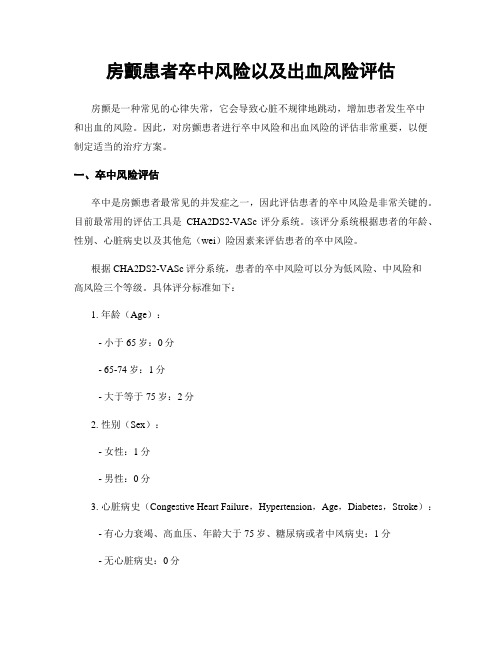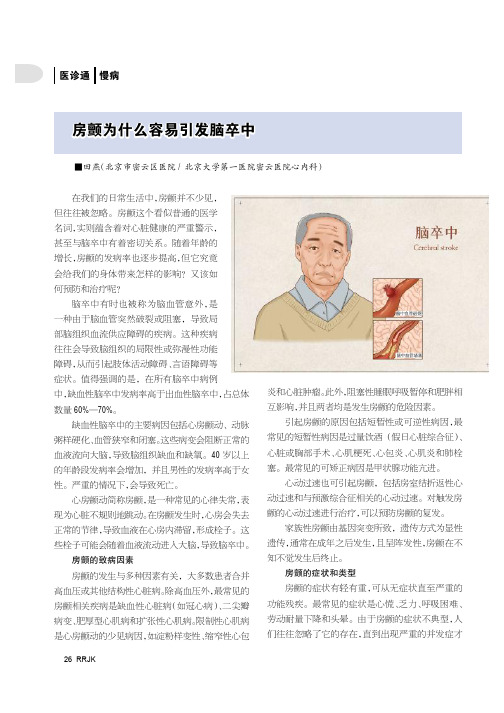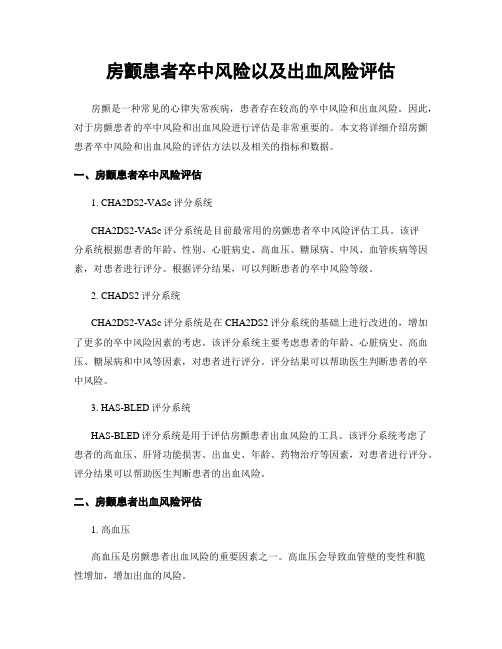房颤患者脑卒中类型及发病机制分析
房颤患者卒中风险以及出血风险评估

房颤患者卒中风险以及出血风险评估房颤是一种常见的心律失常,患者心脏的房间隔不规则收缩,导致心脏泵血功能下降,容易引起血栓形成,增加患者发生卒中的风险。
同时,房颤患者在使用抗凝药物治疗时,也会增加出血的风险。
因此,对房颤患者进行卒中风险和出血风险的评估非常重要。
卒中风险评估:卒中风险评估是根据患者的临床特征和危(wei)险因素来判断患者发生卒中的概率。
常用的评估工具包括CHADS2评分和CHA2DS2-VASc评分。
1. CHADS2评分:CHADS2评分是根据以下五个指标进行评分:年龄≥75岁(1分)、有高血压(1分)、有糖尿病(1分)、有心力衰竭(1分)、有先前的卒中或者短暂性脑缺血发作(2分)。
根据评分结果,将患者分为低危(0分)、中危(1-2分)和高危(≥3分)三个级别。
2. CHA2DS2-VASc评分:CHA2DS2-VASc评分是在CHADS2评分的基础上增加了一些附加因素。
除了原有的五个指标外,还增加了年龄在65-74岁之间的患者(1分)、女性性别(1分)和有血管疾病的患者(1分)。
根据评分结果,将患者分为低危(0分)、中危(1分)和高危(≥2分)三个级别。
出血风险评估:出血风险评估是根据患者的临床特征和危(wei)险因素来判断患者使用抗凝药物治疗时发生出血的概率。
常用的评估工具包括HAS-BLED评分。
1. HAS-BLED评分:HAS-BLED评分是根据以下九个指标进行评分:高血压(1分)、肝肾功能不全(1分)、出血史或者易出血(1分)、卒中史(1分)、年龄≥65岁(1分)、药物或者酒精滥用(1分)、同时使用抗血小板药物或者非甾体类抗炎药物(1分)、血压不受控制(1分)、使用抗凝药物(1分)。
根据评分结果,将患者分为低危(0-2分)和高危(≥3分)两个级别。
综合评估:在评估房颤患者的卒中风险和出血风险时,可以根据CHADS2和HAS-BLED 评分的结果,综合判断患者是否适合使用抗凝药物进行治疗。
急性脑卒中并发房颤相关因素临床分析

急性脑卒中并发房颤相关因素临床分析作者:王波海王翔张慧敏来源:《中外医疗》2013年第11期[摘要] 目的探讨急性脑卒中并发房颤的临床特点,并提出防治措施。
方法对该院神经内科2010年12月—2012 年11月收治的436例急性脑卒中患者临床资料进行回顾分析,了解房颤发生率及发生相关因素。
结果 436例患者共发生房颤61例,总发生率14%;32例患者在卒中后24 h内出现房颤,占52.5%,18例患者在卒中后24~48 h内出现房颤,占29.5%。
年龄越大、神经功能缺损程度越严重(NIHSS评分评估)者,房颤发生率越高。
结论急性脑卒中后48小时内房颤发生率最高;年龄、神经功能缺损严重程度(NIHSS评分评估)是急性脑卒中并发房颤的危险因素。
[关键词] 脑卒中;房颤;因素分析[中图分类号] R43 [文献标识码] A [文章编号] 1674-0742(2013)04(b)-0008-02急性脑卒中后可以出现继发性心脏损害,出现心律失常。
房颤是脑卒中后最常见的心律失常类型之一,若不及时处理,可能出现心源性栓塞再次发生,加重患者病情;此外,房颤可以进一步发展为室颤等恶性心律失常,引起血液动力学失衡甚至心源性猝死,严重影响患者预后[1-2]。
尽管如此,目前仍没有急性脑血管病后房颤发生率、临床特点、危险因素等方面的研究报道。
为探讨急性脑卒中并发房颤的临床特点,并提出防治措施,研究对该院神经内科2010年12月—2012 年11月收治的436例老年急性脑血管病临床资料进行回顾分析,以了解脑卒中后房颤发生的相关因素,现报道如下。
1 资料与方法1.1 一般资料436例脑卒中患者,均符合1995年全国脑血管病学术会议制定的诊断标准[3],全部经头颅CT或MRI检查证实,且发病24 h内就诊,既往无冠心病、心肌梗死、心律失常及心力衰竭病史。
1.2 方法所有患者皆于入院当天完成标准12导联心电图检查,并分别于入院后2 d、3 d、1 周复查;对发现房颤者进行心电监护。
脑卒中的病理生理机制解析

脑卒中的病理生理机制解析脑卒中(Cerebrovascular Accident,简称CVA)是指由于脑血管病变引起的脑功能障碍。
常见的脑卒中类型包括缺血性脑卒中(Ischemic Stroke)和出血性脑卒中(Hemorrhagic Stroke)。
脑卒中是一种严重的疾病,对患者的脑功能和生活质量造成了严重影响。
了解脑卒中的病理生理机制对于预防和治疗脑卒中具有重要意义。
一、缺血性脑卒中的病理生理机制缺血性脑卒中是由于脑血流供应不足导致脑部组织缺氧而引起的。
最常见的原因是脑动脉阻塞,主要包括动脉粥样硬化和栓子形成。
下面简要介绍缺血性脑卒中的主要病理生理机制:1. 动脉粥样硬化:动脉粥样硬化是导致脑卒中最常见的病因之一。
它是由于血管壁发生结构性变化,形成斑块(atheroma),导致血管狭窄和阻塞。
斑块中的胆固醇、钙质和纤维蛋白堆积会引起血管内皮损伤并激活凝血系统。
最终,血小板聚集和血栓形成引起血流堵塞,导致脑组织缺血。
2. 栓子形成:栓子是脑卒中的另一个常见病因。
栓子的形成通常是由于原发病灶(如心房颤动、动脉瘤、动脉炎等)中血栓的脱落或形成,从而堵塞脑部动脉供血。
栓塞是缺血性脑卒中的主要机制之一。
3. 脑缺氧和能量代谢紊乱:脑缺血会导致脑部组织缺氧,因为脑组织对氧气的需求量非常高。
缺氧会导致细胞内能量代谢紊乱,细胞无法正常进行氧化磷酸化反应从而产生ATP,这将导致ATP供应不足,影响细胞功能。
二、出血性脑卒中的病理生理机制出血性脑卒中是由于脑血管破裂造成的脑出血,是脑卒中的另一种常见类型。
出血性脑卒中可以分为蛛网膜下腔出血、脑实质内出血和脑室内出血。
下面介绍出血性脑卒中的主要病理生理机制:1. 高血压:高血压是出血性脑卒中最主要的危险因素之一。
长期高血压会导致脑部血管壁变薄和弹性降低,易于破裂。
此外,高血压还会增加血管通透性和破坏血液-脑屏障,从而促进出血的形成。
2. 血管畸形:血管畸形是出血性脑卒中的另一个重要原因。
急性脑卒中并发房颤相关因素临床分析

急性脑卒中并发房颤相关因素临床分析
王 波 海 王 翔z 张 慧敏
1 . 湖南省邵 阳市第二人民医院脑 科 , 湖南邵 阳
4 2 2 0 0 0 ; 2 . 山东大学附属省立医院神 经内科 , 山东济南
2 5 0 0 2 1
【 摘要】 目的 探讨急性脑卒中并发房颤 的临床特点 , 并提 出防治措施 。 方法 对该院神经 内科 2 0 1 0年 1 2 月一2 0 l 2年 1 1 月
收治的 4 3 6例急性脑卒 中患者临床资料进行 回顾分析 ,了解房颤发生率及发生相关 因素 。结果 4 3 6例患者共发生房颤 6 1 例, 总发生率 1 4 %; 3 2例患者在卒 中后 2 4 h内出现房颤 , 占5 2 . 5 %, 1 8例患者在卒中后 2 4 — 4 8 h内出现房颤 , 占2 9 . 5 %。 年龄 越大 、 神经功 能缺损 程度越严 重 ( N I H S S评分评估 ) 者, 房颤发生率越高 。结论 急性脑卒 中后 4 8小时 内房颤发生率最高 ; 年 龄、 神经功能缺损严重程度( N I H S S评分评估) 是急性脑卒中并发房颤 的危 险因素。
p a r t me n t o f n e u r l o l g y , P r o v i n c i a l Ho s p i f a l a f i f l i a t e d t o S h a n d o n g On i v e r s i t y , J i n a n 2 5 0 0 2 1 , C h i n a
p r o p o s e s o me p r e v e n t i v e me a s u r e s .M e t h o d s Cl i n i c a l d a t a o f 4 3 6 p a t i e n t s wi t h a c u t e c e r e b r o v a s c u l a r d i s e a s e d u i r n g D e c e mb e r
心房颤动患者的脑卒中风险评估及危险因素的最新进展

ABC评 分 重 视 生 物 标 志 物 水 平 对 卒 中 预 测 的 价 值。年龄、卒 中 /短 暂 性 脑 缺 血 发 作 史、N末 端 脑 钠 肽前体以及高敏心肌肌钙蛋白 I对卒中预测的区分
度和一致 性 均 好 于 CHA2DS2VASc,即 使 删 除 卒 中 / 短暂性脑缺 血 发 作 史 (ABC评 分 中 权 重 最 高 的 危 险 因素 ),ABC评 分 的 风 险 预 测 能 力 依 旧 显 著 好 于 CHA2DS2VASc,针 对 低 危 患 者 (年 卒 中 发 生 率 < 1%),ABC评 分 是 比 CHA2DS2VASc更 灵 敏 的 预 测 模 型 [2]。 23 ATRIA评分
表 1 房颤患者卒中风险评分的适用特征
d?
!"#$
%&
'&
!"#$%&$ d?
/$!"#%&$ )0)
()*+,-./01 56789:;12/<= 0+ 'D#EF/GHI JK+,-LM
2+,34
,>?34212@ABC0
NOP+,34212?QRCP
*$!"#$%&$'#&( )1$
相较于最初的 CHADS2,CHA2DS2VASc大幅增加 了高危患者的检出率,但预测能力尚不足(C指数 < 07)。保留 CHA2DS2VASc主体的改良版本 则 较 原 版本统计效力有着部分提高。 11 R2CHADS2
R2(renalrisk)指 肾 病 风 险。肾 小 球 滤 过 率 < 60mL/(min·1.73m2)的患者房颤发病率远高于一般
房颤死亡最常见原因

房颤死亡最常见原因房颤是一种心律失常,即心脏的心房部分出现不规则而快速的心跳。
它是导致中风、心力衰竭、急性冠状动脉综合征等严重并发症的主要原因之一。
房颤患者的死亡通常是由这些严重并发症引起的。
下面将探讨房颤死亡的最常见原因。
1. 中风: 中风是房颤患者最常见的死亡原因之一。
由于心房颤动会导致血液在心脏内积聚,并形成血栓。
当血栓脱落并被携带到脑血管时,它会堵塞血管,导致中风。
中风后果严重,可能导致残疾甚至死亡。
2. 心力衰竭: 心房颤动会影响心脏的泵血功能,导致心脏无法有效地将血液泵出体内。
长期心房颤动可能导致心脏扩大,心室功能不全,最终发展为心力衰竭。
心力衰竭时,心脏无法为身体提供足够的氧和营养素,导致疲劳、呼吸困难、水肿等症状出现,严重时可能导致死亡。
3. 急性冠状动脉综合征: 房颤患者由于心率不规则并且加快,会增加心脏负担,可能导致心肌缺血和供血不足。
当冠状动脉发生血栓形成或破裂时,就会发生急性冠状动脉综合征,如心肌梗死或心绞痛。
这些情况都可能导致心脏功能严重受损,甚至导致死亡。
4. 其他并发症: 房颤患者还可能面临其他并发症,例如心房颤动导致心房扩张和血栓形成,从而导致肺栓塞。
肺栓塞指的是血栓堵塞肺动脉,影响肺血流。
肺栓塞严重时可能导致呼吸窘迫和休克,威胁生命。
此外,房颤患者还可能发生心律失常,如室性心律失常或心室颤动,这些都可能导致心搏停止和猝死。
总结起来,房颤死亡的最常见原因包括中风、心力衰竭、急性冠状动脉综合征和其他严重并发症。
这些并发症通常是由于心房颤动导致心脏泵血功能异常、血栓形成和心率异常等引起的。
由于房颤的高风险性和严重后果,早期诊断和有效管理房颤对于预防这些致命并发症的发生至关重要。
例如,抗凝药物可以减少血栓形成的风险,心律调整药物可以控制心律失常,降压药物可以控制血压等。
此外,房颤患者定期进行医学检查、积极控制相关疾病(如高血压、糖尿病)、健康饮食、适度运动、避免酗酒和抽烟等生活方式改变也是降低死亡风险的重要措施。
房颤患者卒中风险以及出血风险评估

房颤患者卒中风险以及出血风险评估引言概述:房颤是一种常见的心律失常疾病,患者容易发生卒中和出血等风险。
为了准确评估房颤患者的卒中风险和出血风险,医生需要综合考虑多个因素,并采取相应的预防措施。
本文将从五个大点出发,详细阐述房颤患者卒中风险和出血风险的评估方法。
正文内容:1. 卒中风险评估:1.1 年龄:年龄是评估房颤患者卒中风险的重要因素。
年龄越大,患者的卒中风险越高。
1.2 性别:女性患者相比男性患者更容易发生卒中。
1.3 高血压:高血压是房颤患者卒中风险的独立危险因素。
1.4 糖尿病:糖尿病患者患卒中的风险较高。
1.5 其他并发症:如心力衰竭、心肌梗死等,也会增加房颤患者的卒中风险。
2. 出血风险评估:2.1 风险因素评估:评估患者是否存在出血的风险因素,如年龄、高血压、肾功能不全等。
2.2 抗凝治疗评估:评估患者是否适合抗凝治疗,因为抗凝药物可能增加出血的风险。
2.3 出血风险评分:根据患者的出血风险因素,进行评分,以确定患者的出血风险等级。
2.4 出血风险预测模型:利用出血风险预测模型,综合考虑多个因素,对患者的出血风险进行评估。
3. 卒中风险评估工具:3.1 CHA2DS2-VASc评分:该评分系统包括年龄、性别、高血压、糖尿病等多个因素,可以帮助医生评估房颤患者的卒中风险。
3.2 HAS-BLED评分:该评分系统包括高血压、肝肾功能不全、出血史等多个因素,可以帮助医生评估房颤患者的出血风险。
4. 预防措施:4.1 抗凝治疗:对于高卒中风险的房颤患者,抗凝治疗是预防卒中的主要手段。
4.2 抗血小板治疗:对于低卒中风险的房颤患者,抗血小板治疗可以减少卒中的发生。
4.3 控制卒中风险因素:如控制高血压、糖尿病等,可以降低房颤患者的卒中风险。
4.4 出血风险评估和管理:对于高出血风险的房颤患者,需要谨慎使用抗凝药物,并进行定期的出血风险评估和管理。
5. 总结:通过综合评估房颤患者的卒中风险和出血风险,医生可以制定个体化的预防措施,降低患者的卒中和出血风险。
缺血性脑卒中合并房颤房扑的管理课件

可能出现意识障碍或 抽搐。
可伴有头痛、眩晕、 恶心、呕吐等表现。
诊断标准
符合缺血性脑卒中的诊断标准。
心电图或动态心电图检查发现房 颤或房扑。
排除其他可能导致类似症状的疾 病。
鉴别诊断
需要与脑出血、短暂性脑缺血 发作等其他脑血管疾病进行鉴 别。
需要与癫痫、TIA等其他可能导 致抽搐的疾病进行鉴别。
定期评估
定期评估患者的心理状态,及 时发现并处理心理问题。
THANK YOU
适量运动
每周进行至少150分钟的中等强度 有氧运动,如快走、骑车或游泳等 ,增强心肺功能和代谢水平。
控制体重
保持健康的体重范围,避免肥胖, 有助于降低心脑血管疾病的风险。
控制危险因素
控制血压
定期监测血压,遵循医生的建议 ,合理使用降压药物,将血压控
制在正常范围内。
控制血糖
糖尿病患者应严格控制血糖水平 ,定期监测血糖,遵循医生的药病因和发病机制病因
缺血性脑卒中合并房颤房扑的病因较 为复杂,主要包括动脉粥样硬化、高 血压、糖尿病等。
发病机制
缺血性脑卒中合并房颤房扑的发病机 制涉及多个方面,包括心脏和脑血管 病变的相互影响、炎症反应、氧化应 激等。
02
缺血性脑卒中合并房 颤房扑的诊断
临床表现
突然出现单侧肢体无 力、麻木或失语等症 状。
训练。
定期评估
定期评估患者康复效果 ,调整康复计划,以达
到最佳康复效果。
心理支持与疏导
心理护理
关注患者的心理状态,给予心 理支持和安慰,帮助患者树立 信心,积极配合治疗和康复。
认知行为疗法
对患者进行认知行为疗法,纠 正不良认知,改善情绪状态。
家属支持
房颤患者卒中风险以及出血风险评估

房颤患者卒中风险以及出血风险评估房颤是一种常见的心律失常,它会导致心脏不规律地跳动,增加患者发生卒中和出血的风险。
因此,对房颤患者进行卒中风险和出血风险的评估非常重要,以便制定适当的治疗方案。
一、卒中风险评估卒中是房颤患者最常见的并发症之一,因此评估患者的卒中风险是非常关键的。
目前最常用的评估工具是CHA2DS2-VASc评分系统。
该评分系统根据患者的年龄、性别、心脏病史以及其他危(wei)险因素来评估患者的卒中风险。
根据CHA2DS2-VASc评分系统,患者的卒中风险可以分为低风险、中风险和高风险三个等级。
具体评分标准如下:1. 年龄(Age):- 小于65岁:0分- 65-74岁:1分- 大于等于75岁:2分2. 性别(Sex):- 女性:1分- 男性:0分3. 心脏病史(Congestive Heart Failure,Hypertension,Age,Diabetes,Stroke):- 有心力衰竭、高血压、年龄大于75岁、糖尿病或者中风病史:1分- 无心脏病史:0分4. 血管疾病(Vascular Disease):- 有冠心病、外周动脉疾病或者主动脉斑块:1分- 无血管疾病:0分5. 年龄(Age):- 65-74岁:1分- 大于等于75岁:2分6. 性别(Sex):- 女性:1分- 男性:0分7. 临床状况(Clinical Status):- 稳定:0分- 不稳定:1分根据患者的得分,可以将其卒中风险分为低风险(得分0)、中风险(得分1-2)和高风险(得分≥3)三个等级。
根据患者的卒中风险等级,医生可以制定相应的治疗方案,如使用口服抗凝药物或者抗血小板药物来预防卒中的发生。
二、出血风险评估除了卒中风险,房颤患者还需要评估出血风险,因为抗凝治疗可能增加患者出血的风险。
目前最常用的评估工具是HAS-BLED评分系统。
该评分系统根据患者的年龄、肝功能、肾功能、血红蛋白水平、历史出血史、血压和药物使用情况来评估患者的出血风险。
房颤为什么容易引发脑卒中

在我们的日常生活中,房颤并不少见,但往往被忽略。
房颤这个看似普通的医学名词,实则蕴含着对心脏健康的严重警示,甚至与脑卒中有着密切关系。
随着年龄的增长,房颤的发病率也逐步提高,但它究竟会给我们的身体带来怎样的影响?又该如何预防和治疗呢?脑卒中有时也被称为脑血管意外,是一种由于脑血管突然破裂或阻塞,导致局部脑组织血流供应障碍的疾病。
这种疾病往往会导致脑组织的局限性或弥漫性功能障碍,从而引起肢体活动障碍、言语障碍等症状。
值得强调的是,在所有脑卒中病例中,缺血性脑卒中发病率高于出血性脑卒中,占总体数量60%—70%。
缺血性脑卒中的主要病因包括心房颤动、动脉粥样硬化、血管狭窄和闭塞。
这些病变会阻断正常的血液流向大脑,导致脑组织缺血和缺氧。
40岁以上的年龄段发病率会增加,并且男性的发病率高于女性。
严重的情况下,会导致死亡。
心房颤动简称房颤,是一种常见的心律失常,表现为心脏不规则地跳动。
在房颤发生时,心房会失去正常的节律,导致血液在心房内滞留,形成栓子。
这些栓子可能会随着血液流动进入大脑,导致脑卒中。
房颤的致病因素房颤的发生与多种因素有关,大多数患者合并高血压或其他结构性心脏病。
除高血压外,最常见的房颤相关疾病是缺血性心脏病(如冠心病)、二尖瓣病变、肥厚型心肌病和扩张性心肌病。
限制性心肌病是心房颤动的少见病因,如淀粉样变性、缩窄性心包炎和心脏肿瘤。
此外,阻塞性睡眠呼吸暂停和肥胖相互影响,并且两者均是发生房颤的危险因素。
引起房颤的原因包括短暂性或可逆性病因,最常见的短暂性病因是过量饮酒(假日心脏综合征)、心脏或胸部手术、心肌梗死、心包炎、心肌炎和肺栓塞。
最常见的可矫正病因是甲状腺功能亢进。
心动过速也可引起房颤,包括房室结折返性心动过速和与预激综合征相关的心动过速。
对触发房颤的心动过速进行治疗,可以预防房颤的复发。
家族性房颤由基因突变所致,遗传方式为显性遗传,通常在成年之后发生,且呈阵发性,房颤在不知不觉发生后终止。
房颤患者卒中风险以及出血风险评估

房颤患者卒中风险以及出血风险评估房颤是一种常见的心律失常疾病,患者存在较高的卒中风险和出血风险。
因此,对于房颤患者的卒中风险和出血风险进行评估是非常重要的。
本文将详细介绍房颤患者卒中风险和出血风险的评估方法以及相关的指标和数据。
一、房颤患者卒中风险评估1. CHA2DS2-VASc评分系统CHA2DS2-VASc评分系统是目前最常用的房颤患者卒中风险评估工具。
该评分系统根据患者的年龄、性别、心脏病史、高血压、糖尿病、中风、血管疾病等因素,对患者进行评分。
根据评分结果,可以判断患者的卒中风险等级。
2. CHADS2评分系统CHA2DS2-VASc评分系统是在CHA2DS2评分系统的基础上进行改进的,增加了更多的卒中风险因素的考虑。
该评分系统主要考虑患者的年龄、心脏病史、高血压、糖尿病和中风等因素,对患者进行评分。
评分结果可以帮助医生判断患者的卒中风险。
3. HAS-BLED评分系统HAS-BLED评分系统是用于评估房颤患者出血风险的工具。
该评分系统考虑了患者的高血压、肝肾功能损害、出血史、年龄、药物治疗等因素,对患者进行评分。
评分结果可以帮助医生判断患者的出血风险。
二、房颤患者出血风险评估1. 高血压高血压是房颤患者出血风险的重要因素之一。
高血压会导致血管壁的变性和脆性增加,增加出血的风险。
2. 肝肾功能损害肝肾功能损害会导致凝血功能异常,增加出血的风险。
患者的肝肾功能情况需要进行评估,以确定出血风险。
3. 出血史患者的出血史也是评估出血风险的重要指标。
如果患者有较多的出血史,说明其出血风险较高。
4. 年龄年龄是影响房颤患者出血风险的重要因素之一。
随着年龄的增加,患者的出血风险也会增加。
5. 药物治疗房颤患者通常需要接受抗凝治疗或抗血小板治疗,这些药物也会增加出血的风险。
因此,患者的药物治疗情况需要考虑在内,以评估其出血风险。
总结:房颤患者的卒中风险和出血风险评估是非常重要的,可以帮助医生制定合理的治疗方案和预防措施。
房颤患者卒中风险以及出血风险评估

房颤患者卒中风险以及出血风险评估房颤是一种常见的心律失常,患者在发作时心脏上室不规则搏动,导致心脏泵血功能下降,容易引起血栓形成,增加卒中风险。
同时,房颤患者在接受抗凝治疗时也会增加出血风险。
因此,对房颤患者进行卒中风险以及出血风险评估至关重要。
一、卒中风险评估1.1 CHA2DS2-VASc评分系统根据年龄、性别、心血管疾病史、高血压、糖尿病等因素进行评分,评估患者的卒中风险。
1.2 左心房内血栓检测通过超声心动图检查左心房内是否存在血栓,评估卒中风险。
1.3 心房颤动持续时间长期持续的心房颤动会增加患者的卒中风险,需要及时干预治疗。
二、出血风险评估2.1 HAS-BLED评分系统根据高血压、肝肾功能不全、出血史等因素进行评分,评估患者的出血风险。
2.2 年龄年龄越大,出血风险越高,需要谨慎选择抗凝治疗方案。
2.3 抗凝药物的选择不同种类的抗凝药物对出血风险的影响不同,需要根据患者的具体情况选择适合的药物。
三、综合评估3.1 个体化治疗方案根据患者的卒中风险和出血风险综合评估,制定个体化的治疗方案。
3.2 定期复查定期复查患者的心脏功能、血栓形成情况和出血风险,及时调整治疗方案。
3.3 多学科团队协作心内科、神经科、心脏外科等多学科团队协作,共同为房颤患者提供全面的评估和治疗。
四、预防措施4.1 生活方式干预戒烟、限酒、控制体重、定期运动等生活方式干预有助于降低卒中和出血风险。
4.2 合理用药根据患者的具体情况选择合适的抗凝药物和抗血小板药物,避免药物不良反应。
4.3 定期随访定期随访患者的病情变化,及时调整治疗方案,预防并发症的发生。
五、总结房颤患者的卒中风险和出血风险评估是治疗的基础,需要综合考虑患者的个体差异和病情特点,制定合理的治疗方案。
通过科学的评估和预防措施,可以有效降低患者的并发症发生率,提高生活质量。
希翼未来能有更多的研究和临床实践,为房颤患者提供更好的治疗方案。
房颤患者卒中风险以及出血风险评估

房颤患者卒中风险以及出血风险评估引言概述:房颤是一种心律失常,患者易发生卒中和出血等并发症。
因此,对房颤患者进行卒中风险和出血风险评估至关重要,以制定合理的治疗方案,降低患者的并发症风险。
一、卒中风险评估:1.1 左心房内血栓形成风险:房颤患者左心房内血栓形成是导致卒中的主要原因之一。
评估左心房内血栓形成风险可采用CHA2DS2-VASc评分系统,包括年龄、性别、心衰、高血压、糖尿病等因素。
1.2 卒中发生风险:除了左心房内血栓形成外,房颤患者还存在其他卒中发生风险,如高血压、糖尿病、心衰等。
综合评估这些因素可更准确地评估患者的卒中风险。
1.3 抗凝治疗策略:根据患者的卒中风险评分,制定相应的抗凝治疗策略,包括口服抗凝药物和抗凝治疗的监测。
二、出血风险评估:2.1 高龄:房颤患者中高龄是出血风险的重要因素之一。
高龄患者出血风险较大,需要谨慎选择抗凝治疗方案。
2.2 肝功能:肝功能受损的患者出血风险增加,因为肝脏是凝血因子的合成和清除中心。
评估患者的肝功能可以更好地预测出血风险。
2.3 抗凝治疗监测:定期监测患者的凝血功能和抗凝药物浓度,及时调整剂量,可以有效降低出血风险。
三、综合评估:3.1 制定个性化治疗方案:根据患者的卒中和出血风险评估结果,制定个性化的治疗方案,包括抗凝治疗、抗血小板治疗等。
3.2 定期复查和监测:房颤患者需要定期复查心电图、凝血功能、肝功能等指标,及时调整治疗方案,降低并发症风险。
3.3 多学科团队合作:卒中和出血风险评估需要多学科团队合作,包括心脏内科、神经内科、血液科等,共同制定最佳治疗方案。
四、治疗策略选择:4.1 抗凝治疗:对于高卒中风险的房颤患者,口服抗凝药物是首选治疗方案,如华法林、达比加群等。
4.2 抗血小板治疗:对于低卒中风险但高出血风险的患者,可以考虑口服抗血小板药物,如阿司匹林、氯吡格雷等。
4.3 个体化治疗:根据患者的具体情况和风险评估结果,个体化选择治疗方案,以平衡卒中和出血风险。
心房颤动患者缺血性脑卒中的发生率及其影响因素分析

【 中图分类号】R 7 4 3 . 3
[ 文献标识码】 B
[ 文章编号】1 6 7 3 — 9 7 0 1 ( 2 0 1 3 ) 1 0 — 0 1 1 3 — 0 2
An a l y s i s o f i n c i d e n c e o f i s c h e mi c s t r o k e i n p a t i e n t s wi t h a t r i a l i f b r i l l a t i o n a n d i t c t o r s
c a u s e s f o r t h e o c c u r r e n c e o f i s c h e mi c s t r o k e i n p a t i e n t s wi t h a t r i a l ib f r i l l a t i o n ; p a t i e n t s wi t h p e r s i s t e n t a t r i a l i f b il r l a t i o n
心房颤动合并脑卒中患者危险因素的研究

(hnogQnzo og nhsil hn og 6 0 , h a Sadn i huR nj opt , adn 2 0 C i ) g u aS 25 n
【 bt c】 O jcv :o xle h a af r ao s ie i s f t so soe n r ep go s Me os A s at r beteT p r t t l b ltna o a dwt rk a o rt k adso r ns . t d : i e o e r i i s ct i i l hi c rf r tk o i h
患者 8 , 0例 分析脑卒 中患者 的危险因素 以及心房颤动对脑卒 中患者 的预后影响 。结 果 :0 脑卒 中患者 中,0 为心房颤动合 并脑卒 中患 8例 4例
者 , 院死亡发生率达 1% , 住 5 而对照组住院死亡发生率为 5 , % 心房颤动组 明显高于对照组 , 快速型房颤合并脑卒 中 1 6人 , 院死亡率 2 % , 住 5 房
21 0 2年 5月
中国民康 医学
Me ia o r a fC i e e P o l He l d c l u n lo h n s e p e J at h
Ma 2 2‘ y, 01 Vo . 4 F M No. I2 H 9
第2 4卷
上半月
第 9期
【 论
F o 2 0 o 2 1 n o rh s i l 0 c s so e e r l p pe y p t ns ain sw t t k n t a b l t n rs a t r n p o — r m 0 5 t 0 0 i u o p t a e f r b a o lx ai t ,p t t i sr ea d ar l r l i ik fc os o r g a8 c a e e h o i f i ao i n sso ain swi t k f c . s l :8 a e f a in sw t t k ,4 a e fara b l t n c mp iae t ee r l印 - o i f t t t s o eef t Re u t p e h r e s 0 c s so t t i sr e 0 c s so t l r l i o l td wi c r b a p e h o i fi ao i c h o lx ain s o pt l e e t ae w s1 % ,w i ec n r l r u o pt l e e t c u e n5 ,ara b l t n w ssg p e y p t t ,h s i i d d ah r t a 5 e az h l t o to o p h s i i d d ah o c  ̄ d i % eh g az t l r l i a i — i f i ao i nf a t ih rt a n te c n r l o p,r p d ar lf r lt n a s cae i t k 6,i i c n l h g e h n i h o to u i y r g a i ti b l i s o itd w t s o e 1 a ii ao h r n—h s i lmotl y i 5 ,ar — o p t rai n 2 % a t t a f i i l b i a in wi t k 4 i % , o p tl rai . n l so s At a b i ain a s ca e t t k r u f o p tl rai a rl t t sr e2 n 8 l o h o h s i t l y Co cu i n : r l rl t s o itd wi s o eg o p o s i tl y w s a mo t i f i l o h r h a mo t sg i c n l ih rc mp r d w t ec n r l ru r p d ara f r lt n c mp iae t e e r l t k ai n s t t a b i a i nf a t hg e o a e i t o to o p; a i t l b l i o l td wi c r b a r e p t t wi ar l rl — i y hh g i i ao i c h so e h i f i l t n c mb n d w t y a c s o e p t n s u d r o n n ain r l y i ih B t e h wo o h m e e sait al in f i o ie i d n mi t k ai t n e g i g ip t tmo t i s hg . ewe n te t ft e w r tt i l sg i — o h r e e at sc y i
心房颤动卒中风险评估进展(完整版)

心房颤动卒中风险评估进展(完整版)一、房颤卒中风险评估发展史从最初1991年Framingham研究证实房颤增加卒中风险开始,卒中风险评估经历了预测精度提高和从识别高危患者转为排除低危患者的主要历程。
2001年,CHADS2评分首次建立,发表于美国医学会杂志(JAMA)。
在这项美国人群的队列研究中(n=1733),CHADS2评分凭借较高的预测准确度(C指数0.82),被用于进行房颤患者卒中风险的评估6。
该评分综合了最主要的卒中风险因素,包括心力衰竭(C-congestive heart failure)、高血压(H-hypertension)、高龄(A-age ≥75)、卒中及短暂性脑缺血发作史(S-stroke or transient ischemic attack)。
该评分的优点在于能够识别卒中高危患者(CHADS2 ≥2分),但该评分中0-1分的患者也有相当高的卒中风险。
2010年,在CHADS2评分的基础上,一项研究对卒中风险进行了再分层,建立了CHA2DS2-VASc评分,成为目前房颤卒中风险评估和抗凝策略制定的基石7。
该评分增加了血管疾病(V-vascular disease)和性别(S-sex category)因素,同时将年龄分为三层(<65, 65-74, ≥74)。
藉此,CHA2DS2-VASc评分提高了房颤卒中风险评估的准确性。
更重要的是该评分能有效识别卒中低危患者(0-1分)。
在被CHADS2评分判定为低危的患者中,仍然有1.4%/年的卒中风险;而被CHA2DS2-VASc判定为低危的患者未发生栓塞、卒中事件,可以不进行抗凝治疗。
目前该评分在众多人群中得到验证,受到诸多国际权威指南的推荐。
二、卒中风险评估国际研究现状目前针对房颤卒中风险评估研究主要集中于以下几个方面:现有评分模型的验证及改进;应用生物标志物进行卒中风险分层;卒中风险的动态评估;各房颤亚型对卒中风险的影响;房颤射频消融后卒中风险评估与决策制定。
脑卒中患者心律失常的发病类型和危险因素分析

年龄大于或等于 6 5岁
男 性 心 肌 梗 死
高 血 压
7 2 ( 8 6 . 7 ) 4 9( 5 9 . 0 ) 4 ( 4 . 8 )
5 9 ( 7 1 . 1 ) 1 9 ( 2 2. 9 )
文献标识码 : C 文章编号 : 1 6 7 1 — 8 3 4 8 ( 2 0 1 4 ) 0 9 — 1 1 5 1 - 0 2
近年来 , 脑 卒 中 已经 成 为 了危 害 我 国 中老 年人 生命 健 康 的 重 要 疾 病 。脑 卒 中可 引 起 脑 源 性 心律 失 常 , 急 性 脑 缺 血 性 脑 卒 中 和 出血 性 脑 卒 中 的 患 者 中 有 2 o ~4 O 可 发生 心律 失常 ,
1 资 料 与 方 法
1 . 1 一般资料
研究对象 为 2 0 0 8年 1 O月 至 2 0 1 2年 9月 期
间入 住 本 院 的 3 5 0例 心 律 失 常 患 者 , 其 中男 1 9 3例 , 女 1 5 7例 , 年龄 4 8 ~7 l岁 , 平均( 6 0 . 8 ±1 6 . 5 ) 岁, 分 为 脑 卒 中心 律 失 常
登 记 两 组 患 者 病 例 时 收 集 以下 数 据 : 性别、 年龄、
对 照 组
( n 一 2 6 7 )
P
心 律 失 常类 型 以 及 各 种 并 发 症 包 括 甲状 腺 功 能 亢 进 和减 退 症 、 心脏病 、 慢性阻塞型肺疾病 、 肺栓塞 、 高血 压 、 糖尿病 、 肾 功 能 衰 竭、 消化 道 疾 病 、 睡眠呼吸暂停综合征 、 自身 免 疫 性 疾 病 等 。实
房颤患者卒中风险以及出血风险评估

房颤患者卒中风险以及出血风险评估房颤是一种常见的心律失常,患者容易发生血栓形成并导致卒中。
因此,对房颤患者进行卒中风险评估非常重要。
此外,房颤患者在使用抗凝药物时也会面临出血的风险,因此需要进行出血风险评估。
本文将详细介绍房颤患者卒中风险评估和出血风险评估的标准和方法。
1. 房颤患者卒中风险评估:卒中风险评估是根据患者的临床特征和相关因素来确定其发生卒中的风险程度。
目前最常用的评估工具是CHA2DS2-VASc评分系统,其中各项指标及其分值如下:- Congestive Heart Failure (心力衰竭):1分- Hypertension (高血压):1分- Age ≥ 75 years (年龄≥75岁):2分- Diabetes (糖尿病):1分- Stroke or TIA (卒中或者短暂性脑缺血发作):2分- Vascular disease (血管疾病):1分- Age 65-74 years (年龄65-74岁):1分- Sex category (女性):1分根据CHA2DS2-VASc评分系统的得分,患者被分为低危、中危和高危三个等级。
得分为0的患者被认为是低危患者,不需要抗凝治疗。
得分为1的患者可以考虑使用抗凝药物进行预防性治疗。
得分为2及以上的患者应该进行抗凝治疗。
2. 房颤患者出血风险评估:出血风险评估是为了评估房颤患者在使用抗凝药物时发生出血的风险。
最常用的评估工具是HAS-BLED评分系统,其中各项指标及其分值如下:- Hypertension (高血压):1分- Abnormal renal or liver function (肾功能或者肝功能异常):1分- Stroke history (卒中病史):1分- Bleeding history or predisposition (出血病史或者易出血):1分- Labile INR (国际标准化比值不稳定):1分- Elderly (年长者):1分- Drugs or alcohol (药物或者酒精):1分根据HAS-BLED评分系统的得分,患者被分为低风险(得分0-2分)和高风险(得分≥3分)两个等级。
- 1、下载文档前请自行甄别文档内容的完整性,平台不提供额外的编辑、内容补充、找答案等附加服务。
- 2、"仅部分预览"的文档,不可在线预览部分如存在完整性等问题,可反馈申请退款(可完整预览的文档不适用该条件!)。
- 3、如文档侵犯您的权益,请联系客服反馈,我们会尽快为您处理(人工客服工作时间:9:00-18:30)。
非瓣膜性房颤患者脑卒中类型及发病机制分析【摘要】目的回顾性分析我院心房颤动脑卒中患者的脑梗死类型及相关发病因素,以探讨非瓣膜性房颤患者发生脑卒中可能存在的发病机制和意义。
方法对2005年9月至2007年9月在我院住院和门诊的房颤并发脑卒中患者进行调查,观察分析瓣膜性和非瓣膜性心房颤动合并脑卒中患者的梗死类型和相关发病因素的区别,筛选非瓣膜性心房颤动发生脑卒中的可能病因和机制。
结果瓣膜性房颤和非瓣膜性房颤脑卒中患者有相同的危险因素:心衰、高纤维蛋白原,也有不同的危险因素:瓣膜性房颤脑卒中与过快的心室率(即:频速型房颤)关系密切,非瓣膜性房颤脑卒中则与高血压、动脉硬化、高脂血症、高血糖的关系密切;非瓣膜性房颤与瓣膜性房颤发生脑卒中的类型不同,瓣膜性房颤发生大动脉栓塞的可能性大,而非瓣膜性房颤发生脑卒中的类型多种多样,包括大动脉栓塞、皮层支梗死、分水岭梗死及腔隙性梗死,特别以分水岭梗死为多。
结论非瓣膜性心房颤动病人可能发生不同类型的脑梗死,发病机制除了心源性栓子脱落造成脑栓塞外,还包括其它不同机制引起的梗死,包括血流动力学改变、动脉粥样硬化斑块形成或脱落、血液流变学改变等,而分水岭梗死的多发则提示血流动力学的改变应为其发生脑梗死的可能病因和重要机制;同时,非瓣膜性房颤脑卒中患者合并高血压、动脉硬化、高脂血症、高血糖的机率大,因而,对卒中的预防除了强调抗凝之外应包括:较好地控制心室率、控制血压、血糖、血脂水平,只有从综合防治的角度出发,改善血流动力学状态,控制血液流变学因素,逆转动脉硬化程度等,才能起到防治中风的目的。
【关键词】非瓣膜性房颤卒中发病机制Stroke categories of non valvular atrial fibrillation andanalyses of their pathogenesis【Abstract 】Objective To probe into the possible pathogenesis and its significance of cerebrovascular disorders of the patients with non-valvular atrial fibrillation (abbreviated to non-VAF) by restropectively analyzing the categories of cerebral infarct and their related pathogenic factors of the non-VAF patients from my hospital. Methods I have screened out the possible etiogenic mechanism of cerbrovascular disorders of the non-VAF patients through investigation into some inpatients and outpatients from my hospital between 2005 and 2007 with auricular fibrillation complicated by cerebrovascular disorders,and by carefully observing and analyzing of the distinctions of the categories of cerebral infarct and their related pathogenesis between stroke patients with valvular auricular fibrillation (abbreviated to VAF) and those with non-VAF.Results Stroke patients with non-VAF and those with VAF share the same hazard factors : heart failure, high fibrinogen; also they have different risk factors:VAF-related cerebrovascular disorders are tightly connected with fast ventricular rhythm, i.e. frequent auricular fibrillation, however, non-VAF-related cerebrovascular disorders are closely connected with hypertension, arteriosclerosis, hyperhipemia and hyperglycemia. Stroke patients with non-VAF and those with VAF fall into different categories. VAF is more likely to occur with aortic embolism, whilenon-VAF may be accompanied by a wide variety of cerebrovascul-ardisorders,including aortic embolism, cortical branch infarct ,watershed infarct and lacunar infarct and so on ,especially of watershed infarct.Conclusion Non-VAF patients may suffer from a variety of cerebral infarction, whose pathogenesis involves not only cerebral thrombosis caused by scaling-off cardiogenic emboli, but also embolism triggered by some other mechanisms, including hemodynamic changes, atherosclerotic plaque formations or scales-off,hemorheologic changes and so on;while frequently-occurring watershed infarct suggests that hemodynamic changes may be the pathogenesis of cerebral infarct.In the meantime,stroke patients with non-VAF have a higher risk of cocurrently developing hypertention, arteriosclerosis, hyperlipemia, and hyperglycemia. Therefore, preventive measures taken besides specially applying anticoagulants should include good control over ventricular rhythm , blood pressure, and levels of blood sugar and blood fat. The intentional precautions against cerebrovascular disorders can only be fulfilled by imposing integrated controls to improve the stateof hemodynamics, to check the hemorheologic factors and to reverse the degree of arteriosclerosis and so on.Key Wordsnon-valvular atrial fibrillation;stroke ;pathogenesis非瓣膜性房颤患者脑卒中类型及发病机制分析心房颤动是临床常见的持续性心律失常, 也是脑卒中的独立危险因素,既往我们对房颤引起脑卒中的认识集中在脑栓塞方面,这与过去瓣膜性房颤(valvular atrial fibrillation,VAF)发病率高有关,随着近年来非瓣膜性房颤(non-valvular atrial fibrillation,NVAF)患者的增多,我们发现临床上许多NVAF患者发生的缺血性脑卒中的类型是多种多样,心源性血栓栓子脱落引起栓塞只是其中的一部分,还有许多的不同脑梗死类型的存在,这是否预示着NVAF患者脑卒中的发生与VAF不同,存在除栓塞以外的不同发病机制?带着这个疑问,笔者对近年来就诊我院房颤并发脑梗死患者的影像学表现及临床资料进行研究和分析,探讨其相关因素和可能存在的发病机制。
1研究对象与方法1.1研究对象选择2005年9月至2007年9月在我院住院和门诊诊断为心房颤动并脑卒中的患者。
年龄>18岁,心电图、动态心电图及相关病史记录证实有心房颤动存在。
1.2房颤及脑卒中的诊断标准房颤指持续时间超过30秒且与可逆性病因无关的房颤发作。
在心电图上表现为P波消失,代之以振幅、形态、间距绝对不规则f波(频率在240~320次/min)及绝对不规律的心室激动。
脑卒中的诊断标准参照Framingham研究[1],根据患者的临床表现及且必须经影像学证实。
1.3房颤及脑卒中的分型房颤根据病因可分为VAF及NVAF,VAF:主要指风湿性房颤;NVAF:符合房颤的诊断标准,经临床和超声心动图排除风湿性心脏瓣膜疾病者;根据心室率分为,频速型房颤:心室率〉90次/分,非频速型房颤:心室率< 90次/分。
脑卒中的分型方法是按发病机制并结合影像学表现[2],分为A型(即以大脑动脉主干梗死型为主,包括大面积脑梗死和出血性脑栓塞)、B型(即以分水岭梗死为主),C型(即以腔隙性梗死为主),D型(以皮层支脑梗死为主、包括单发、多发小梗死),;同时,将B、C、D型梗死定义为非主干梗死型;1.4调查内容采用回顾性病历分析的方法,阅读住院和门诊病历记录,按统一调查表格,填写以下项目:1)一般情况:性别、年龄。
